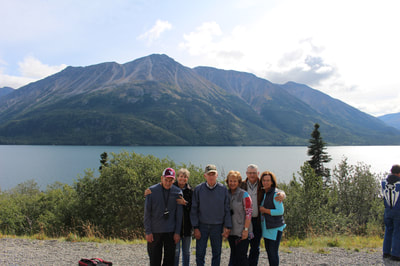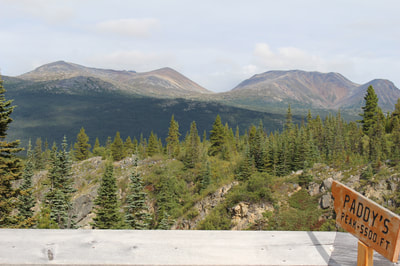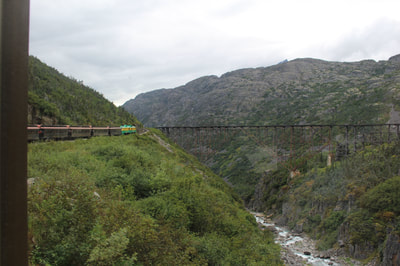
Thanks to www.articwebsite.com for posting the above picture to their website. When one does research on Skaway at https://en.wikipedia.org/wiki/Klondike_Gold_Rush the picture above brings to light the hardships people endured to try to win their fortune in the gold fields. Those dots on the right of the picture are people with large packs on their backs climbing the mountain.
Here is a snippet from the Wikipedia page ...
The Klondike Gold Rush was a migration by an estimated 100,000 prospectors to the Klondike region of the Yukon in north-western Canada between 1896 and 1899. Gold was discovered there by local miners on August 16, 1896, and, when news reached Seattle and San Francisco the following year, it triggered a stampede of prospectors. Some became wealthy, but the majority went in vain. It has been immortalized in photographs, books, films, and artifacts.
To reach the gold fields, most took the route through the ports of Dyea and Skagway in Southeast Alaska. Here, the Klondikers could follow either the Chilkoot or the White Pass trails to the Yukon River and sail down to the Klondike. Each of them was required to bring a year's supply of food by the Canadian authorities in order to prevent starvation. In all, their equipment weighed close to a ton, which for most had to be carried in stages by themselves. Together with mountainous terrain and cold climate, this meant that those who persisted did not arrive until summer 1898. Once there, they found few opportunities, and many left disappointed. (https://en.wikipedia.org/wiki/Klondike_Gold_Rush)
Armed with a bit of the history, we travelers arrived in Skaway on our fourth day of the cruise. The weather was looking to be a high of 52 degrees, Cloudy, and a chance of rain. As you can see in the insert, we arrived in Skagway with temperature of 50 degrees at 0643 am.
Today, our excursion starts in Skagway and we venture into the Yukon Territory to see what the country looks like today. In lieu of heavy backpacks, horses, and the snow, we travel in a bus to the summit of White Pass. Next we traveled to the "Tutshi Canyon to cross the "Yukon Suspension Bridge ." I am told the bridge is 57 feet above the river and the river is a class 4 and 5 river. That means it moves real fast down the mountain. to board the train back to Skagway. Prior to heading back down the mountain on the train, we enjoy some bison chili and I had to try their "Lead Dog Ale" with my chili. Today, our excursion is SK76A, the "Yukon Adventure and White Pass Scenic Railway." The below pictures are from the trip up the mountain via the bus...
Here is a snippet from the Wikipedia page ...
The Klondike Gold Rush was a migration by an estimated 100,000 prospectors to the Klondike region of the Yukon in north-western Canada between 1896 and 1899. Gold was discovered there by local miners on August 16, 1896, and, when news reached Seattle and San Francisco the following year, it triggered a stampede of prospectors. Some became wealthy, but the majority went in vain. It has been immortalized in photographs, books, films, and artifacts.
To reach the gold fields, most took the route through the ports of Dyea and Skagway in Southeast Alaska. Here, the Klondikers could follow either the Chilkoot or the White Pass trails to the Yukon River and sail down to the Klondike. Each of them was required to bring a year's supply of food by the Canadian authorities in order to prevent starvation. In all, their equipment weighed close to a ton, which for most had to be carried in stages by themselves. Together with mountainous terrain and cold climate, this meant that those who persisted did not arrive until summer 1898. Once there, they found few opportunities, and many left disappointed. (https://en.wikipedia.org/wiki/Klondike_Gold_Rush)
Armed with a bit of the history, we travelers arrived in Skaway on our fourth day of the cruise. The weather was looking to be a high of 52 degrees, Cloudy, and a chance of rain. As you can see in the insert, we arrived in Skagway with temperature of 50 degrees at 0643 am.
Today, our excursion starts in Skagway and we venture into the Yukon Territory to see what the country looks like today. In lieu of heavy backpacks, horses, and the snow, we travel in a bus to the summit of White Pass. Next we traveled to the "Tutshi Canyon to cross the "Yukon Suspension Bridge ." I am told the bridge is 57 feet above the river and the river is a class 4 and 5 river. That means it moves real fast down the mountain. to board the train back to Skagway. Prior to heading back down the mountain on the train, we enjoy some bison chili and I had to try their "Lead Dog Ale" with my chili. Today, our excursion is SK76A, the "Yukon Adventure and White Pass Scenic Railway." The below pictures are from the trip up the mountain via the bus...

After we ate our chili and walked across the bridge, we all loaded back on the bus to ride back to the Canadian Customs Check Point at Fraiser. Fraser is the first place that the railroad tracks meet the South Klondike Highway, outside of Skagway. Here we went through Canadian Customs. No pictures here ... this picture is from the website http://wpyr.com/sights-sounds/places/fraser-british-columbia/.
Our group has had the pleasure of traveling up the mountain via a well paved highway. Our predecessors followed narrow trails along rivers as well as climbing steep inclines. We exit the bus only to board he train for the downhill portion of our trek. Might I say, we did it in the warmth of the bus and the train. I was really warm in my seat because it was located directly in front of the on board stove similar to the one in my grandmothers house. Be it known, I was coming out of the jacket and other clothes I could remove. The following pictures are just a few of the many I took coming down the mountain. There were just too many to post all of them here. Please enjoy the pictures ...









































 RSS Feed
RSS Feed